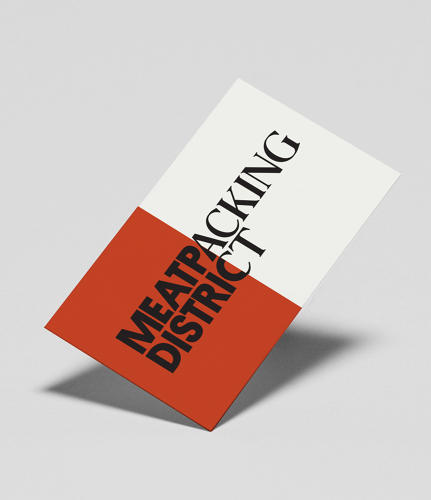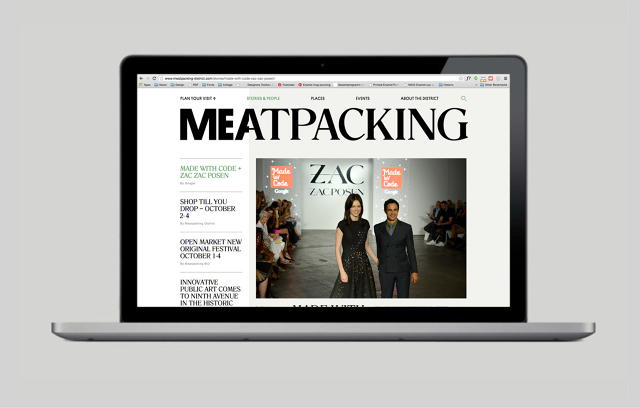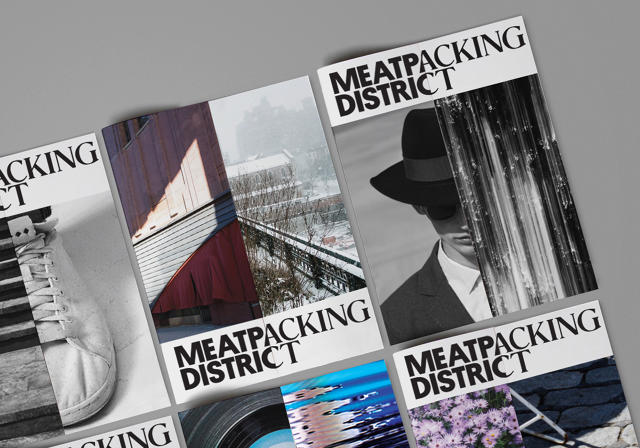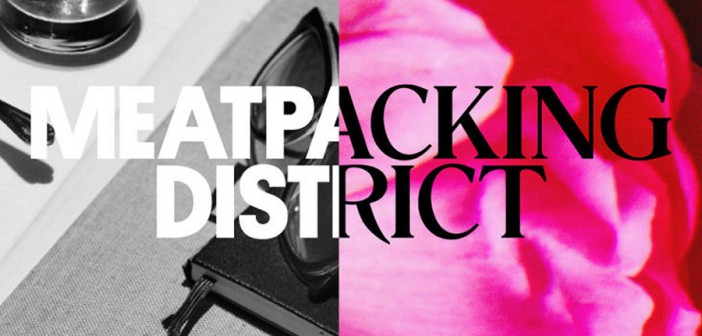NYC’s Meatpacking District Is Now A Brand
In a couple of decades, New York City’s Meatpacking District has gone from industrial to illicit to fiercely fashionable. Today it is home to Google, Diane von Furstenberg’s flagship store, the new Renzo Piano-designed Whitney Museum, the southern terminus of the High Line (arguably the most influential public park in recent years), and any number of exclusive nightclubs. And now, it has a brand to match.

The Meatpacking business improvement district enlisted Base Design to devise a visual identity that captures the neighborhood’s transformation into a consumer and cultural mecca. Anchored by a wordmark that divides “Meatpacking District” into two different typefaces, it suggests a neighborhood with multiple personalities: equal parts ritzy and wild.
Branding a place is not new. The Austin Independent Business Association adopted a slogan of Keep Austin Weird. Colorado adopted a new logo a couple years ago. Bruce Mau created Know Canada to shed light on the country’s lesser-known attributes. When places organize around a brand, it’s a strategy to cash in on the commodity of “location, location, location.” Make it cool, get people to pass through, and buy a T-shirt while you’re at it. (The Meatpacking rebranding includes merchandise, like T-shirts, sweatshirts, tote bags, water bottles, and notebooks.)

But that was only part of the goal here. Meatpacking‘s BID also wanted to reposition the neighborhood away from its reputation for go-go (if sometimes sordid) nightlife. “In the past five years, the businesses in the neighborhood have diversified, but the perception hasn’t changed,” says Lauren Danziger, director of the Meatpacking‘s business improvement district. “We have nightlife, and we’re proud of that, but it’s a one-dimensional view of a neighborhood that’s super dynamic and that has more going on.”
To devise its strategy, Base interviewed the Meatpacking District’s business owners and residents to find out what sets the neighborhood apart from the rest of the city. “The inspiration behind the identity is really this juxtaposition of history and the future, this kind of inherent contraction that exists,” Geoff Cook, a partner at Base, says.
Many neighborhoods in New York feature layer after layer of history, but the Meatpacking, more so than others, has undergone a radical shift from the “Drag Queen Stroll” of the 1980s and gritty industrial zone of the 1990s to the domain of tony shopping trendsters of the 2000s. Today only a handful of meatpackers remains in the district.

Base first completed the district’s logo, which is composed of two typefaces: Platform and Romana. The wordmark is split vertically and where the shift occurs can vary, a nod to the dynamic nature of the neighborhood. Signage features the logo along with evocative photographs of fashion, the iconic cobblestone streets, and architectural details, artwork, and lifestyle images. After that, Base came up with the slogan “The New Original” to speak to the neighborhood’s character. “It’s really a nod to the positioning,” Cook says. “It’s the core of what we’re expressing though the identity and the study in contrasts.” The visual identity appears on merchandise sold at the clothing store Theory and the Whitney’s gift shop; banners; storefronts; and a Meatpacking District website.

The website is one of the most in-depth products from the rebranding. It serves as a virtual stand-in for the neighborhood and is kind of like a virtual bulletin board for what’s happening there. It’s not only for community news—anyone can post to the site, though the Meatpacking BID moderates content—but it’s the public-facing portal into what’s available to see, eat, and do in the area. Visitors can download maps, businesses can post news, and residents can read up on what their neighbors are working on.
Of course, branding an entire neighborhood is the ultimate commercial move—a nail in the coffin for the Meatpacking‘s past lives. As far back as 2001, a New York Times story voiced concern about the impending “generification” of the neighborhood. That prophecy came true. It’s easy to get drunk off of nostalgia, but today the Meatpacking District is about fashion, museums, restaurants, and commerce. With a cohesive identity, it’s finally getting the visuals to convey its spirit.
[All Images: via Base Design]


